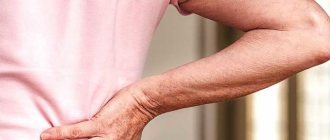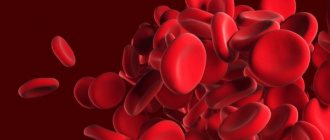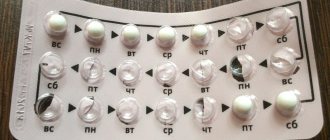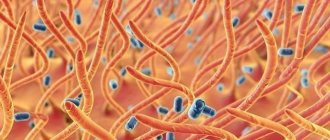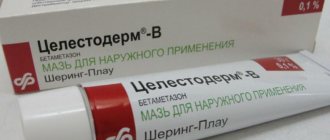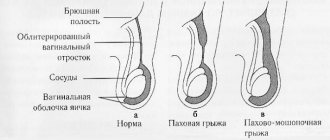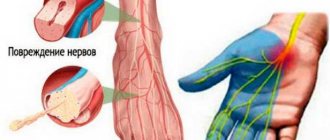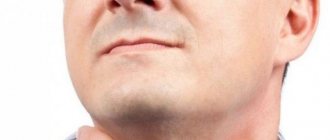Dermatomyositis
(
dermatomyositis
; Greek derma, dermat[os] skin + mys, myos muscle + -itis; synonym:
Wagner disease, Wagner-Unferricht-Hepp disease
) - a disease characterized by impaired motor function as a result of systemic damage to the striated and to a lesser extent smooth muscles, as well as skin lesions. Belongs to the group of diffuse connective tissue diseases.
The acute form of Dermatomyositis was described by Wagner (E. Wagner, 1863), Unferricht (H. Unverricht, 1887) and Hepp (P. Hepp, 1887), the chronic form - by Petge and Clejat (G. Petges, S. Clejat, 1906). As a diffuse systemic disease of connective tissue, dermatomyositis has been studied only since the 40s. 20th century
Dermatomyositis occurs at any age; predominates in women. Incidence 1: 200,000 - 1: 280,000 [Rose and Walton (A. Bose, J. Walton), 1966; Medsger, Dawson, Masi (T. Medsger, W. Dawson, A. Masi), 1970].
Etiology
Etiology unknown. A number of authors consider dermatomyositis as a sensitization reaction to various antigens (microbial, tumor, etc.). This concept is supported by the wedge, manifestations of the disease, such as erythema nodosum (see Erythema nodosum), urticaria (see), eosinophilia (see), often observed at the onset of the disease. Norton (W. Norton) et al. (1970), Klug and Sonnichsen (N. King, N. Sonnichsen, 1973) discovered virus-like cytoplasmic inclusions in the affected tissues (in the cytoplasm of skin fibroblasts, in the endothelium of capillaries of the skin and muscles, sarcoplasm of muscle fibers) and on this basis consider the possible role of viruses in etiology D.
Pathogenesis
The pathogenesis is not well understood. The most recognized hypothesis is the autoimmune mechanism of development of D. Autoimmune disorders are indicated by the presence of antibodies to skeletal muscles. Muscle damage can also be caused by cellular immune reactions (delayed-type reactions); This idea is confirmed by experimental data: when guinea pigs are administered a heterogeneous muscle suspension with Freund's adjuvant (see Adjuvant), the animals develop generalized myositis, reminiscent of D. in humans.
Pathological anatomy
Rice.
1. Microslide of altered skeletal muscle in dermatomyositis: necrosis of muscle cells (1) and inflammatory infiltration (2) are pronounced. In dermatomyositis, autopsy shows generalized damage to skeletal muscles. The muscles are swollen, pale, gray or yellowish-brown, with areas of necrosis, fibrosis and calcification (see). Microscopically morphol. changes in muscles are very variable and depend on the stage and pace of the disease, as well as the age at which the disease arose. There is focal protein degeneration (see) and vacuolar degeneration (see) of myocytes, followed by necrosis and macrophage reaction from the stroma (Fig. 1). The lesions are surrounded by an infiltrate consisting predominantly of small lymphocytes and plasma cells located around the vessels or diffusely between muscle fibers. Subsequently, interstitial fibrosis develops, against the background of which there is an intensification of regenerative processes on the part of myocytes. The intensity of interstitial fibrosis depends on the nature of the course, duration and stage of the disease. Fibrosis is more often observed in acute massive necrosis of muscle cells, which develops when treatment is started late. As a result of the disease, atrophy of muscle fibers develops (see Muscle atrophy), alternating with focal compensatory hypertrophy.
Electron microscopically, with an exacerbation of the process, focal degeneration of muscle cells and the formation of cytoplasmic hyaline bodies are observed.
Thickening of the endothelium and basement membrane of intramuscular arterioles and capillaries is observed. Quite often, virus-like inclusions are found in endothelial cells, reminiscent of those in systemic lupus erythematosus (see).
Foci of necrosis and edema with mucous degeneration (see), as well as fibrosis and calcification are found in the skin and subcutaneous tissue.
Changes similar to changes in skeletal muscles are found in the myocardium, but much less pronounced. Endocarditis and pericarditis are extremely rare. Possible fatty liver. Basically, visceral changes are reduced to moderate inflammatory-sclerosing processes in the stroma, vasculitis (see Vasculitis) and minor damage to the smooth muscles that make up the organs.
With D., changes are noted in the motor terminal nerves and their endings. Dystrophic and regenerative processes are observed in them. There is also a relationship between the severity of changes in muscles and nerve fibers.
For pathomorphol, changes in D. in children are characterized by a predominance of destructive panvasculitis, which is not limited only to muscles or skin, but also extends to the gastrointestinal tract. tract, heart, lungs, peripheral nerves, etc. Intimal hyperplasia and fibrosis of the vascular wall lead to occlusion and hypoxic changes in organs.
Symptoms
The disease always starts with the appearance of general symptoms, as well as skin manifestations. Muscle damage develops much later, which is due to their significant volume in the body. Therefore, you need to start describing the symptoms with general signs, which are often left aside during diagnosis:
- In most cases, the onset of the disease and each exacerbation is accompanied by fever. Its severity, depending on the course of the process, can be varied. In acute forms, the temperature may rise to 40 degrees and severe chills. The chronic course can be accompanied only by a mild fever (no more than 37.5).
- Unmotivated fatigue occurs, which does not disappear even after prolonged active or passive rest. Performance also decreases progressively.
- The patient experiences rapid weight loss, which is associated with constant fever, as well as a decrease or complete absence of appetite.
All these signs determine the chronic inflammatory process present in the body, and therefore are not specific only to dermatomyositis.
Skin lesions
Since the diagnosis is usually determined by clinical signs, skin manifestations constitute half of the criteria for its confirmation. These include three characteristic symptoms of the disease:
- The first and leading one is considered to be a heliotrope rash - this name is given because its appearance resembles sunburn on exposed areas of the body. Multiple merging red or purple spots appear on the skin of the scalp, face, neck, and upper extremities.
- Gottron's sign is the appearance of large red spots over the dorsum of the joints of the hands. The redness may weaken and intensify over time, then the rash turns into plaques with peeling.
- The last characteristic sign is “mechanic’s hand” - damage to the skin of the palms and fingers, accompanied by redness, cracking, and peeling. At the same time, similar manifestations are observed in the area of the periungual ridges.
Skin symptoms usually precede muscle symptoms by an average of several months, which makes them the leading criterion in the early diagnosis of the disease.
Muscle damage
Involvement of muscles in the pathological process occurs gradually - skeletal muscle tissue is affected first, and only then smooth muscles. Therefore, we can distinguish two main stages, which have their own clinical characteristics:
- The first period is accompanied by the development of symmetrical weakness of the proximal muscles of the limbs - the pelvic and shoulder girdle, as well as the neck flexors. Because of this, the patient’s gait changes – it becomes clumsy, hobbling. Difficulties arise when performing simple movements - getting out of bed, getting out of a chair, getting into a vehicle.
- The second stage develops against the background of progression of the process in the skeletal muscles with simultaneous damage to the muscles of the internal organs. Swallowing food becomes difficult, the voice changes, and a paroxysmal cough appears due to the constant entry of food into the respiratory tract. The final result is damage to the respiratory muscles, which leads to impaired ventilation of the lungs.
Despite the pronounced muscle weakness, other subjective symptoms (pain, swelling) are extremely rarely present, as a result of which the disease can proceed relatively unnoticed by the patient.
Damage to internal organs
Since smooth muscle is present in almost any organ, in the later stages of the disease there is a progressive dysfunction of most of them. Therefore, we need to list the most common types of lesions:
- Most often, a progressive decrease in lung function is observed - and it has two pathological mechanisms behind it. The first is caused by disruption of the respiratory muscles with a subsequent decrease in gas exchange. And the second is caused by the development of chronic inflammation in the lung tissue, which is associated with the retention of mucus in the bronchi due to a decrease in their tone.
- Less common is damage to the heart associated with the inflammatory process in its muscle tissue. Usually it has a hidden course and is detected only in the later stages, when severe heart failure develops.
- It is extremely rare that the gastrointestinal tract is involved in the pathological process, accompanied by the development of inflammatory processes in it - erosive gastritis or colitis.
If treatment for dermatomyositis at the stage of damage to internal organs is absent or carried out inadequately, then the risk of fatal complications in the patient increases several times.
Clinical picture
There is no generally accepted classification of Dermatomyositis. There are idiopathic, primary, and symptomatic, secondary, Dermatomyositis, which develops in response to tumor antigens, and Dermatomyositis in children.
Secondary dermatomyositis is not fundamentally different from primary dermatomyositis in its clinical picture. According to Williams (R. Williams, 1959), secondary D. is observed in 17% of cases; among patients with D. over 40 years of age, the frequency of secondary D. increases to 50%. D.'s symptoms may precede the manifestations of the tumor by months or even years. Most often, D. is observed in tumors of the lung, prostate, ovary, uterus, mammary gland, and colon. Individual cases of D. have been described in malignant lymphomas, as well as in benign and malignant thymomas. According to the nature of the course, acute, subacute and hron forms D are distinguished. The acute form is characterized by fever with chills, rapidly increasing generalized damage to skeletal muscles, progressive dysphagia (see), dysphonia (see), damage to the heart and other organs. Acute D. is rarely observed in adults. The subacute form has a slower course. The disease most often begins with gradually increasing muscle weakness, the edges are revealed during physical examination. stress (climbing high steps, washing clothes, etc.), less often with the phenomena of dermatitis. Later, damage to the muscles of the shoulder and pelvic girdle intensifies, dysphagia and dysphonia occur. After 1 - 2 years from the onset of the disease, a detailed picture of D. is usually observed with severe damage to the muscles and visceral organs. Chron, the form of D. occurs cyclically, the processes of atrophy and sclerosis of muscles and skin predominate for a long time, isolated muscle groups of the distal extremities (muscles of the forearms, shins) may be involved in the process. Muscle damage is often combined with chronic recurrent dermatitis (see).
rice. 4. Some clinical manifestations of dermatomyositis - periorbital erythema and edema (symptom of “spectacles”), puffiness of the face, bluish-pink coloration of the skin and lips;
Skin lesions in dermatomyositis are polymorphic: erythema (see) and swelling (see) predominate, mainly on exposed parts of the body. Petechial, papular, bullous rashes are observed (see Rash), telangiectasia, foci of pigmentation and depigmentation, hyperkeratosis, etc. Skin, ch. arr. over the affected muscles, swollen, doughy or dense. Erythema is often localized on the face, neck, chest, over the joints, on the outer surface of the forearm and shoulder, on the anterior surface of the thighs and legs; It is highly persistent and is often accompanied by peeling and itching. A peculiar periorbital edema and erythema is characteristic (color Fig. 4) - a symptom of “spectacles”. Trophic disorders, dry skin, longitudinal striations and brittleness of nails, hair loss, etc. are often observed. More than half of the patients have simultaneous damage to the mucous membranes in the form of conjunctivitis (see), stomatitis (see), hyperemia and swelling of the pharynx, as well as vocal folds. Skin syndrome usually precedes the appearance of other signs of D., including muscle damage, but in some patients there are practically no changes in the skin (polymyositis itself).
The cardinal sign of D. is damage to skeletal muscles. Typically, the muscles of the proximal limbs, shoulder and pelvic girdle, neck, back, pharynx, upper esophagus, and sphincters are affected. Muscle pain appears, especially with movement and palpation; muscles are dense or doughy, increased in volume. Steadily progressing muscle weakness is expressed in a significant limitation of active movements. Patients cannot stand up, sit down, raise their leg on a step (the “bus” symptom), hold an object in their hand, comb their hair, get dressed (the “shirt” symptom), and fall easily when walking; if the muscles of the neck and back are affected, they cannot lift their head from the pillow or keep it in an upright position (the head falls on the chest); when the facial muscles are damaged, a mask-like appearance of the face appears. At the height of the development of the disease (in acute and subacute cases), patients are almost completely immobilized; movements are preserved only in the hands and feet.
Involvement of the pharyngeal muscles in the process causes dysphagia (choking when swallowing, liquid food pours out through it). Aspiration of food is possible. Damage to the intercostal muscles and diaphragm leads to limited mobility and decreased vital capacity of the lungs (see). When the muscles of the larynx are damaged, a nasal tone of voice and hoarseness appear; damage to the muscles of the eye leads to diplopia (see), ptosis (see); damage to the sphincter muscles leads to disruption of their activity. Then atrophy of the affected muscles or a picture of myositis ossificans develops (see Myositis). Calcinosis in D. is secondary and has a reparative nature. Foci of calcification are most often localized in the most affected muscles of the shoulder and pelvic girdle and in the subcutaneous tissue in the form of plaques or massive deposits. Foci of calcification located superficially can be opened with the release of a lime mass.
The damage to the nervous system noted in D. gave the Senator (H. Senator, 1888) reason to call the disease neurodermatomyositis. Changes are observed mainly in the peripheral and autonomic nervous system; defeat c. n. With. is observed rarely and is expressed in the form of asthenic depressive and asthenic syndromes (see Asthenic syndrome). The EEG reveals pathological rhythms of biopotentials. Some authors note the possibility of developing meningitis and encephalitis with seizures.
Damage to the peripheral nervous system can manifest itself as radicular pain, pain in the nerve trunks, mono- and polyneuritis (see Polyneuritis). With polyneuritis, sensitivity is impaired, especially in the distal parts of the arms and legs. The decrease in sensitivity, like its increase, is not profound. Reflexes are usually reduced, sometimes unevenly. Decreased or lost tendon reflexes may result from combined damage to the muscles and peripheral motor neuron.
Autonomic disorders are varied - a tendency to hypotension, tachycardia, impaired thermoregulation, anorexia, etc.
Almost half of the patients have focal or diffuse myocarditis (see), sometimes with cardiac arrhythmias and symptoms of congestive heart failure. Endocarditis and pericarditis are rare.
Lung damage is manifested by vascular or interstitial pneumonia, resulting in pulmonary fibrosis (see Pneumosclerosis). Isolated cases of the development of pulmonary calcification have been described. Pulmonary failure occurs relatively rarely and is caused mainly by damage to the respiratory muscles and diaphragm.
Damage to smooth muscles went intestinal. tract leads to hypotension of the esophagus and intestines. Some patients experience decreased appetite, abdominal pain, and gastroenterocolitis (see). Gel.-intestinal. bleeding and intestinal perforation in adult patients are rare. Moderate enlargement of the liver is observed in approximately 1/3 of patients.
Cases of severe glomerulonephritis with hypertension and renal failure in D. are very rare, more often kidney damage is manifested by transient proteinuria (see).
Rare symptoms of D. also include generalized lymphadenopathy and enlarged spleen. In some cases, lesions of the fundus vessels have been described.
Of the general symptoms of the disease, the most common is weight loss, sometimes significant (10-20 kg). Febrile temperature is noted during an acute course or exacerbation of D.; in subacute and chronic cases, subfebrile temperature is recorded.
Arthritis is rare. Approximately 25% of patients experience arthralgia (see) and swelling of the periarticular tissues. Joint dysfunction is associated with muscle damage. Sometimes D. is combined with Raynaud's syndrome (see Raynaud's disease).
Laboratory studies in the acute and subacute course of the disease show moderate anemia, neutrophilic leukocytosis, less often leukopenia, eosinophilia), accelerated ROE, increased alpha-2-1 and gamma globulins. An indicator of the severity and prevalence of muscle damage is an increase in the activity of enzymes in the blood - creatine phosphokinase, glutamic and pyruvic transaminases, lactate and malate dehydrogenases, as well as the appearance of creatine in the urine. With hron, during D., changes in laboratory test data are not so clear and pronounced. A number of patients have an increased titer of rheumatoid factor. Antinuclear antibodies and lupus cells are found extremely rarely.
According to Pearson (S. M. Pearson, 1972), an electromyographic study (see Electromyography) reveals a characteristic triad: spontaneous fibrillation and positive potentials of muscle currents; a polyphasic complex of potentials with low amplitude that appears during voluntary muscle contraction, volleys of high-frequency action potentials (“pseudomyotonia”) after mechanical irritation of muscles.
Forms
Before moving on to the description of individual options, it is necessary to consider the general pathological processes leading to their development. It is only because of their extremely similar course that these forms, despite the different causes of their occurrence, are united under a common concept. Translated from Greek, it means inflammation that affects the skin and muscles.
People will immediately have a logical question: what determines the simultaneous damage to these tissues that are different in structure? And the reason lies precisely in their special internal structure:
- Dermatomyositis is based on chronic systemic inflammation of the microvasculature - small vessels. It is caused by normal white blood cells, but with an altered reactivity directed against their own connective tissues.
- It is the skin and muscles that contain a huge number of capillaries, which ensure that all the necessary needs of these organs are fulfilled.
- At the first stage of the disease, destruction processes predominate in them - the inner lining of the vessels is damaged, after which it ceases to perform barrier functions.
- Temporarily, the body copes with the destruction by restoring old capillary networks and forming new ones.
- But leukocytes continue to continuously attack the vessels, which leads to a gradual spread of the process. At the same time, the external activity of the disease can also occur in different ways - in the form of a continuous process or periodic exacerbations.
- The outcome of such damage after some time is scarring and atrophy - “useless” areas are formed in place of normal tissues, unable to perform their functions.
Dermatomyositis itself is not capable of leading to the death of a person; complications always become lethal when the disease irreversibly affects internal organs.
Juvenile
The appearance of pathological signs in childhood makes up the bulk of the primary forms of the disease. Even modern research has not made it possible to identify the leading mechanism explaining the development of the disease. Although there are certain triggering factors that play a certain role in changing the activity of leukocytes:
- There is a clearly proven genetic predisposition - juvenile dermatomyositis is almost always observed among blood relatives. There is an explanation for this - special antigens from connective tissue have been identified in such people. Under certain conditions, leukocytes can begin to react to them, recognizing them as an element foreign to the body.
- The role of past infections (especially viral ones) has also been noted in changing the reactivity of the immune system in relation to the skin and muscles. Under certain conditions, microbes or their fragments can be carried into distant vessels - connective tissue capillaries. After some time, leukocytes detect them, but do not destroy them immediately, but for some reason start a sluggish inflammatory process.
- The combination of these two factors significantly increases the risk of developing the disease in a child. But for the onset of the disease, a realizing moment is also required - this is usually hypothermia, excessive insolation (stay under the sun's rays) or repeated infection.
Dermatomyositis in children has a malignant course - this is due to the incompleteness of the processes of growth and development against the background of progressive damage to muscle tissue.
Secondary
Although the mechanisms of disease development are the same for all forms, other systemic diseases can also trigger them. Therefore, dermatomyositis may be secondary in nature - then it will be considered only a variant of the manifestation of the underlying disease. Currently, only two serious pathologies can lead to its appearance:
- The first form is considered cross syndrome - the formation of typical symptoms of damage to the skin and muscle tissue against the background of another connective tissue disease. It can be any disease - systemic lupus erythematosus, rheumatoid arthritis, scleroderma or psoriasis. In this case, the underlying pathology can either manifest its characteristic features or occur under the guise of dermatomyositis.
- The second variant of the secondary course is considered to be paraneoplastic damage to the connective tissue. This phenomenon is due to the influence of a malignant tumor on the functioning of all body systems, including the immune system. It has been proven that breast cancer and lung tumors are often accompanied by symptoms characteristic of dermatomyositis.
With the secondary nature of the manifestations, the main attention is paid to the underlying disease - if it is effectively treated, then the signs of skin and muscle damage may gradually disappear.
Complications
The most common and dangerous complication, which ranks first among the causes of death in acute dermatomyositis, is severe aspiration pneumonia (see), which develops as a result of aspiration of food masses with impaired swallowing. Constant hypoventilation of the lungs (see Pulmonary ventilation) due to damage to the intercostal muscles and diaphragm creates the preconditions for the development of bacterial pneumonia. In some cases, severe damage to the respiratory muscles with a sharp limitation of chest excursion can lead to increasing respiratory failure (see) and asphyxia (see). In immobilized patients, trophic ulcers (see), bedsores (see) may occur. Possible development of exhaustion. Heart and kidney failure in D. are relatively rare.
DIAGNOSTICS
Diagnosis of the disease includes interviewing and examining the patient, as well as the use of laboratory and instrumental examination methods:
- X-ray examination allows you to determine the formation of calcifications, changes in the size of the heart muscle and symptoms of osteoporosis;
- collection and study of venous and capillary blood. The level of creatine phosphokinase, aldolase, creatinine, rheumatoid factor titers and ESR are determined. Based on the increase in their indicators, the doctor identifies dermatomyositis;
- OAM. Particular attention is paid to the presence of myoglobin in the urine;
- ECG;
- spirography. Detects the development of respiratory failure;
- muscle biopsy. Using a special device, a small section of muscle tissue is taken to diagnose the presence of inflammation;
- electromyography. With dermatomyositis, muscle excitability is increased.
Diagnosis
The diagnosis is based on the clinical manifestations of the disease, primarily on the characteristic damage to the muscles and skin. Eosinophilia (see), increased enzyme levels, and creatinuria (see) are of diagnostic importance. To clarify the diagnosis of dermatomyositis, electromyographic studies and especially muscle and skin biopsies play an important role. Skin changes in individual patients with D. may be similar to skin lesions in systemic lupus erythematosus; muscle morphology in D. is more characteristic.
In all cases of D., especially in older people, it is necessary to conduct a thorough general clinical examination to exclude a tumor.
Rice. 2. X-ray of the thighs of a patient with dermatomyosygia with severe calcification in the muscles.
X-ray data in D. are not specific, but they can help clarify the degree of damage to soft tissues and internal organs. Radiographs should be produced using the so-called. soft radiation to obtain the structure of soft tissues. In the acute stage of the disease, on such radiographs the muscles look more transparent and clearing is noted. The subcutaneous tissue is very transparent, sometimes even small veins are visible in it. With chronic D. the presence of calcifications in soft tissues is typical (Fig. 2). Irregularly shaped calcifications are most often found in the subcutaneous tissue, and a band type of calcification is sometimes observed at the border of muscles and subcutaneous tissue. In the area of the hip joint there is often extensive calcification—the so-called. pseudotumorous changes.
In the lungs, a picture of interstitial fibrosis is revealed, mainly in the basal sections. Sometimes calcifications are noted in the pleura. The heart is often enlarged.
Differential diagnosis
in acute and subacute dermatomyositis it should be carried out with infectious and neurological diseases, systemic scleroderma (see), systemic lupus erythematosus (see).
With the acute onset of D., when there is fever, chills, accelerated ROE, increasing muscle weakness allows one to exclude infectious diseases (sepsis, typhus, erysipelas, etc.). The rapid development of the disease, immobility, and difficulty swallowing imitate severe polyneuritis (see). Clarification of the genesis and nature of the observed lesions allows us to differentiate false neurological symptoms from true ones.
Scleroderma, as a rule, does not have an acute onset. The leading symptom is dense swelling of the skin without dermatitis.
Unlike systemic lupus erythematosus, with D., visceral pathology is not so pronounced; the picture of the disease is dominated by muscle damage, a different nature of skin changes, and there are no lupus cells in the blood.
Chron. D. without skin syndrome (polymyositis itself) should be differentiated from various myopathies: progressive muscular dystrophy, thyrotoxic myopathy, etc. (see Myopathy). A muscle biopsy is often decisive.
Carrying out diagnostics for polymyositis
In cases of suspected polymyositis, the patient needs to consult a rheumatologist. To differentiate muscle syndrome from myasthenia gravis, you should consult a neurologist. To identify other symptoms from the gastrointestinal tract, lungs and cardiovascular system, consultations with such specialists as: gastroenterologist, pulmonologist, cardiologist are necessary.
When conducting a clinical blood test in patients with polymyositis, characteristic features of the inflammatory process are detected (leukocytosis and acceleration of ESR).
A biochemical blood test shows an increase in the level of “muscle enzymes” (AST, ALT, CPK). In cases of polymyositis, they are used to assess the degree of intensity of the inflammatory process that appears in the muscles.
The need to use electromyography in patients with polymyositis is necessary to exclude other neuromuscular pathologies. It shows increased excitability and sudden fibrillations, low amplitude of action potentials.
To assess the condition of internal organs, the following methods are prescribed:
- Ultrasound of the abdominal organs.
- Coprogram.
- ECG.
- Gastroscopy.
- Ultrasound of the heart.
- X-ray of the lungs.
Treatment
For acute, subacute and exacerbation of chronic dermatomyositis, corticosteroids are prescribed, excluding triamsinolone, which is contraindicated in D., because it can cause myopathy. It is preferable to use prednisolone in adequate, usually large, doses: in acute cases 80-100 mg, in subacute cases 60 mg, in case of exacerbation of chronic conditions. D. 30-40 mg per day. These doses, subject to tolerability and the absence of contraindications, are prescribed for 2-3 months. and more to a clear therapeutic effect. In subsequent months, a very slow reduction in the dose of prednisolone is made to the maintenance dose: in acute and subacute D. during the first year of the disease it should be 30-40 mg; in the second and third years of illness, the maintenance dose is reduced to 20-10 mg; During the period of deep wedge, remission, complete withdrawal of the drug is possible. With exacerbation of the disease and stressful situations, the dose is increased. There are practically no contraindications to the use of corticosteroids (except for triamsinolone) in acute D.
Along with corticosteroids, cytotoxic drugs are used. There are reports of good effects from the use of methotrexate, azathioprine, 6-mercaptopurine, and cyclophosphamide. However, the method of treating D. with cytostatic drugs has not yet been sufficiently developed. Duration of treatment is 2-6 months. When combined with corticosteroids, shorter courses of treatment are used.
Aminoquinoline drugs: quinamine (chloroquine, resoquine, delagil), hydroxychloroquine (Plaquenil) are used for a long time (years), for almost all forms of D. In acute and subacute D., it is advisable to prescribe these drugs during the period of reducing the dose of corticosteroids, for chronic. D.—from the moment of diagnosis.
Depending on the individual characteristics of the disease, non-steroidal anti-inflammatory drugs - salicylates (acetylsalicylic acid) and indomethacin in standard doses - can be used in combination with corticosteroids.
Complex treatment of D. also includes cocarboxylase and B vitamins, as well as anabolic hormones (Nerobol, Retabolil), which are especially indicated for long-term use of corticosteroids or exhaustion of the patient. In the presence of calcification, complexing agents are used, in particular disodium salt of ethylenediaminetetraacetic acid (Na2EDTA).
In acute and subacute D., bed rest, careful care are required, and subsequently a gradual expansion of the range of movements with careful use of individual treatment techniques. physical education. Massage and physiotherapeutic methods of treatment can be used only when there is a clear decrease in the activity of the process and the transition of the disease to chronic form. When the processes of muscle atrophy and fibrosis predominate with the development of contractures, treatment becomes the leading treatment in the therapeutic complex. gymnastics, massage, physiotherapeutic procedures (paraffin baths, electrophoresis with hyaluronidase, etc.). When the activity of the process subsides, balneotherapy and spa treatment are possible.
The diet of patients with D. should be complete, rich in proteins and vitamins.
TYPES AND STAGES
Depending on the provoking factor, dermatomyositis is classified into:
- idiopathic. It is detected in 35-40% of cases, often starting after vaccination;
- secondary tumor. It is provoked by the appearance of malignant tumors;
- children's (juvenile). The x-ray shows calcification of the muscle tissue. The disease has an acute course, characterized by muscle pain, fever, and skin manifestations;
- mixed dermatomyositis, interspersed with other connective tissue diseases.
Depending on the clinical picture of dermatomyositis, acute, subacute and chronic forms are described.
The most striking manifestation of dermatomyositis is damage to the muscle muscles
Stages of dermatomyositis:
- Prodromal. Nonspecific symptoms appear, indicating dermatomyositis;
- Manifest stage. Skin, muscle and other manifestations of the disease begin;
- Dystrophic stage. It is distinguished by the severity of the course, inhibition of all body systems, and the development of complications.
Forecast
The prognosis for untreated acute and subacute D. is poor. Under the influence of timely therapy with corticosteroids, these forms acquire a more benign, hron, course, and in some patients many years of complete remissions occur with restoration of ability to work. Prognosis for life with chronic D. more favorable, the prognosis regarding ability to work is poor.
In secondary D., the prognosis depends on the course of the underlying disease.
Prevention for Dermatomyositis is practically a prevention of exacerbation and progression of the process. It provides for possible early diagnosis of the disease, timely and active treatment in a hospital, and then dispensary observation of patients, adequate supportive therapy, transfer to disability or employment with limited physical activity. load and exclusion of allergenic factors.
How is polymyositis treated?
Treatment for polymyositis is based on the use of glucocorticosteroid drugs. Prescribing such treatment in some cases turns out to be ineffective, since observations have shown improved results in only 30-50% of patients. The use of this therapy for inclusion body myositis is almost completely ineffective.
The lack of improvement in the patient's condition during the treatment of polymyositis gives rise to the prescription of immunosuppressants. First of all, this is the use of the drug methotrexant. The stock drug is azathioprine. When treated with these drugs, monthly biochemical liver tests are required. Therapy for polymyositis also involves the use of drugs such as cyclosporine, chlorambucil, cyclophosphamide, as well as their combination.
Dermatomyositis in children
Clinical picture
The onset is often subacute. However, acute, rapid development of the disease is often observed. Chronic and subacute D. in children can become more active.
Wedge, D.'s manifestations in childhood generally do not differ from those in adults, but the course is more malignant. It is characterized by an undulating, progressive course with increased temperature, severe systemic muscle damage, and severe organ pathology. The variety of wedges and syndromes is associated with the involvement of vessels of different sizes, primarily the microvasculature, in the pathological process.
rice. 1. Some clinical manifestations of dermatomyositis - periorbital erythema and swelling, moderate swelling and bluish-pink coloring of the lips, bilateral ptosis (more on the right); rice. 2. Some clinical manifestations of dermatomyositis - symmetrical erythematous rashes over the interphalangeal joints, a red border around the nail; rice. 3. Some clinical manifestations of dermatomyositis - a widespread vascular pattern on the skin, extensive foci of necrosis;
Skin changes occur with great consistency (polymyositis itself is extremely rare) and, in addition to paraorbital and erythema located above the joints, are often accompanied by widespread edema and deep necrosis of the skin and subcutaneous tissue (color. Fig. 1-3). During the course of the disease, the erythema fades, telangiectasia (see), areas of peeling, hyper- and depigmented spots appear. Above the joints, the skin loses its elasticity, becomes wrinkled, rough or thinned, resembling the so-called. atrophic scars. Various changes in the mucous membranes of the oral cavity, respiratory tract, and conjunctiva are often observed, manifested by catarrhal-ulcerative reactions with edema.
Rice. 3. A child suffering from dermatomyositis. Diffuse muscle atrophy and tendon-muscle contractures are pronounced. rice. 5. Some clinical manifestations of dermatomyositis are multiple moderately raised calcifications above the skin, around some of them there is a wide zone of infiltration.
Diffuse weakness of skeletal muscles with pain and swelling limits the child’s motor capabilities and often leads to almost complete immobility. Children develop tendon-muscular contractures (Fig. 3) and calcification much more often than adults. While in adults the development of muscle calcification means the end of the active phase of the disease, in children widespread calcification can be observed in combination with active D. Sometimes calcifications partially protrude above the surface of the skin (tsvetn. Fig. 5).
Damage to the respiratory and pharyngeal muscles is manifested by dysphagia (see), dysarthria (see), decreased excursion of the chest. Progressive damage to the respiratory muscles can lead to respiratory arrest.
Half of the patients have arthralgia. Arthritis may occur, sometimes with subsequent deformation of the joints.
Damage to the lungs in D. is most often expressed by vascular interstitial pneumonia, characterized by progression of the process, the formation of pulmonary fibrosis, the appearance of signs of cor pulmonale and bronchopneumonia. There may be a layer of secondary infection, pulmonary tuberculosis. Pleurisy can be either dry or exudative, often without significant effusion, with the development of adhesive processes.
Heart damage is more often manifested by diffuse or focal myocarditis (see), myocardial dystrophy and, less often, endomyocarditis, myopericarditis or pancarditis (see). Sometimes ptosis is observed (tsvetn. fig. 1), exophthalmos.
In the active phase of the disease, the vessels of the fundus of the eye are affected to varying degrees.
The phenomena of gastroenterocolitis (see) are observed in half of sick children, sometimes with bleeding, ulcerative processes up to perforation. Abdominal syndrome (see Pseudoabdominal syndrome) usually accompanies a severe wedge picture and is a consequence of widespread vasculitis and degenerative changes (treatment with corticosteroids increases trophic disorders).
Generalized muscle damage often simulates neurol, symptoms, at the same time, true damage to the central and peripheral nervous system occurs with great consistency.
In most cases, D. is accompanied by more or less severe hepatosplenomegaly (see Hepatolienal syndrome) and lymphadenopathy. Accelerated ROE, protein, enzymatic and immunol changes, slight proteinuria with moderate changes in urine sediment are observed. The severity of these changes coincides with the activity of the process.
Treatment
With severe activity of dermatomyositis, prednisolone is prescribed, 1-3 mg per 1 kg of child’s weight per day. When the dynamics of damage to the respiratory and pharyngeal muscles is torpid, it is necessary to use “shock” doses (4-6 mg per 1 kg of body weight per day). When the process stabilizes (usually after 4-8 weeks), the dose is gradually reduced (individually) to maintenance (from 20 to 5 mg per day). Patients receive maintenance therapy for a long time, sometimes for years, while under outpatient supervision. It is advisable to use anticholinesterase agents, salicylates, pyrosolone and quinoline drugs, as well as agents that improve metabolism, trophism and regenerative processes in tissues (anabolic hormones, glutamic and adenazine triphosphoric acids, potassium preparations, vitamins). Antibiotics are prescribed according to indications.
In case of hormone-resistant forms of D. or the development of complications during treatment with corticosteroids (compression fractures of the vertebral bodies, steroid diabetes, ulcers of the gastrointestinal tract, etc.), cytostatics are used, however, due to the frequent development of trophic disorders, the addition of a secondary infection with a high possibility of developing sepsis, their use is limited.
For the treatment of calcifications, disodium ethylenediaminetetraacetic acid (Na2EDTA) is recommended, a single dose of 250 mg to 1 g (5-20 ml of 5% solution). The drug is administered intravenously drip in 350-400 ml of isotonic sodium chloride solution or in 5% glucose solution daily for 5 days, followed by a 5-day interval. There are a total of 15 infusions per course. The course is repeated 2-3 times a year. When D.'s activity decreases, Na2 EDTA is often used in combination with corticosteroid drugs in a moderate dose.
When breathing stops due to progressive damage to the respiratory muscles, controlled breathing is used (see Artificial respiration, artificial ventilation).
In childhood, due to the frequent development of progressive tendon-muscular contractures, great importance is attached to early treatment. gymnastics and massage with a gradual complication of the complex (see Physical therapy, in children; Massage, in children).
Forecast
In some cases, with the timely administration of adequate therapy, it is possible not only to reduce the activity of the process, but also to achieve the transition of the disease into an inactive phase with satisfactory compensatory capabilities of motor function. Chronic, steadily progressing process with severe dystrophy, widespread calcification and irreversible tendon-muscular contractures leads to disability.
In cases where it is not possible to stop a rapidly and malignantly ongoing process, which has an extremely fast, “galloping” course, the disease can lead to death in a few months. The cause of death can also be progressive trophic disorders of the skin, mucous membranes of the respiratory tract and gastrointestinal tract. tract with the development of a secondary infection resulting in sepsis or the occurrence of profuse laryngeal esophageal bleeding and peritonitis. The direct cause of death may be pulmonary heart failure, which develops against the background of irreversible progressive damage to the respiratory muscles.
Prevention
In order to prevent D., children who have increased sensitivity to a number of factors, both environmental and internal, need persistent sanitation of foci of chronic infections. They should be especially careful (taking into account previous allergic reactions) with all types of vaccinations, the use of antibiotics, sulfonamides, plasma and blood transfusions, and the administration of gamma globulin.
For children with D., preventive vaccinations, insolation, physiotherapeutic and thermal procedures (the latter especially in the active phase of the disease) are absolutely contraindicated. Surgical interventions should be carried out in the inactive phase of D. (remission for at least 2 years) against the background of corticosteroid therapy. For intercurrent infection, courses of acetylsalicylic acid and other salicylates are recommended; Antibiotics are prescribed only for absolute indications. It is necessary to actively monitor children with dermatomyositis, ensuring a comprehensive examination and strict monitoring of the implementation of recommended measures.
Bibliography:
Gausmanova-Petrusevich I. Muscular diseases, trans. from Polish, p. 303, Warsaw, 1971; Ishchenko M. M. and Dorogiy A. N. About the clinic and histopathological changes in the nervous system in acute dermatomyositis, Zhurn, neuropath, and psychiat., v. 74, no. 2, p. 209, 1974, bibliogr.; Kopyeva T.N. et al. Metabolism of some skeletal muscle enzymes in dermatomyositis (histochemical study), Arkh. pathol., t. 34, no. 3, p. 46, 1974; Mikheev V.V. Collagenoses in the clinic of nervous diseases, M., 1971; Nesterov A.I. and Sigidin Ya.A. Clinic of collagen diseases, p. 429, M., 1966, bibliogr.; Solovyova A.P. and Vinogradova O.M. Can acute “idiopathic” dermatomyositis be cured? Ter. arkh., t. 47, no. 4, p. 118, 1975; Solovyova A.P., Moiseev V.S. and Cheltsov V.V. Cardiovascular pathology in dermatomyositis, Cardiology, v. 15, no. 5, p. 52, 1975, bibliogr.; Tareev E. M. Collagenoses, p. 267, M., 1965, bibliogr.; Banzhaf M. a. Gopel W. Dermatomyositische Syndrome und ihre immunosuppressive Therapie, Z. arztl. Fortbild., S. 37, 1973; Bohndorf W.u. Schropl F. Rontgen-befunde bei Dermatomyositis, Fortschr. Rontgenstr., Bd 112, S. 531, 1970; Haas DC a. Arnason BGW Cellmediated immunity in polymyositis, Arch. Neurol., v. 31, p. 192, 1974; Logan RG ao Polymyositis, Ann. intern. Med., v. 65, p. 996, 1966; Medsger TA, Dawson WN a. Masi AT The epidemiology of polymyositis, Amer. J. Med., v. 48, p. 715, 1970; Sokoloff M. S., Goldber g L. S. a. Pearson S. M. Treatment of corticosteroid-resistant polymyositis with methotrexate, Lancet, v. 1, p. 14, 1971; Wagner EL Fall einer seltenen Muskelkrankheit, Arch, d. Heilk. (Lpz.), Bd 4, S. 282, 1863.
Dermatomyositis in children
— Isaeva L. A. and Zhvania M. A. Principles of treatment of dermatomyositis in children, Vopr. ocher mat. and children, vol. 15, no. 12, p. 3, 1970, bibliogr.; Mozolevsky Yu. V. Differential diagnosis of dermatomyositis in children, Zhurn, neuropath, and psychiat., t. 74, No. K); With. 1472, 1974, bibliogr.; Banker V. Q. a. Victor M. Dermatomyositis (systemic angiopathy) of childhood, Medicine (Baltimore), v. 45, p. 261, 1966; Bitnum S. ao Dermatomyositis, J. Pediat., v. 64, p. 101, 1964, bibliogr.; Roget J. ea La dermatomyosite de l'enfant, etude de 22 observations, Pediatrie, t. 26, p. 471, 1971; Sullivan DB ao Prognosis in childhood dermatomyositis, J. Pediat., v. 80, p. 555, 1972,
N. G. Guseva, G. P. Kurtinite, A. A. Matulis; M. A. Zhvania, L. A. Isaeva (ped.).
Causes of dermatomyositis
Dermatomyositis, like polymyositis, is an autoimmune disease. And to date, the causes of diseases in which our immunity gets out of control and begins to deal with the cells of our own body have not been established. There is a possibility that there is a genetic predisposition to this disease.
In addition, dermatomyositis can be triggered by influenza viruses, parainfluenza, hepatitis B, as well as parvoviruses, picornaviruses, etc.
The disease may appear after vaccination against measles and rubella.
Also likely to have a negative impact is prolonged exposure to the sun, hypothermia, and allergies to certain types of medications.
The disease is accompanied by disorders of our immunity. Women of menopausal age are susceptible to this disease, when the level of female hormones drops sharply.
Do not rely on intuition, advice from the Internet and recommendations from “experienced” friends. Diagnosis of rheumatological diseases, in particular dermatomyositis, is a very complex process that requires the highest professionalism from the doctor and patience from the patient. A good prognosis can only be achieved with correct treatment of dermatomyositis at an early stage!
Diagnosis of dermatomyositis:
- blood serum testing for CPK (creatine phosphokinase), since this enzyme is one of the main markers of muscle damage;
- a biopsy from the thigh or shoulder muscles (may show a cluster of immune cells);
- needle electromyography (allows you to determine the nature of the lesion: muscular or neurogenic);
- computed tomography of the chest (helps determine the extent of lung damage);
- computed tomography of the thigh (detects swelling of muscle tissue);
- blood test for tumor markers (allows you to exclude tumor processes).
It may be necessary to conduct a comprehensive examination of the gastrointestinal tract, including gastroscopy, colonoscopy and radiography.
1 Diagnosis of dermatomyositis
2 Blood serum test for CPK
3 Blood test for tumor markers
